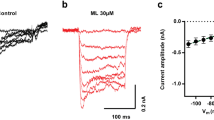Summary.
Linalool is a major component of essential oils and possesses various biological effects in sensory or central nervous systems. To investigate the pharmacological and biophysical effects of linalool on voltage-gated currents in sensory neurons, we used the whole-cell patch clamp and the Ca2+ imaging techniques. Under the voltage clamp, membrane depolarization generated time- and voltage-dependent current responses in newt olfactory receptor cells (ORCs). Linalool significantly and reversibly suppressed the voltage-gated currents in ORCs. The dose-suppression relation of linalool for the voltage-gated Na+ current could be fitted by the Hill equation with a half-blocking concentration of 0.56 mM and a Hill coefficient of 1.2. To test whether linalool suppresses voltage-gated currents in ORCs specifically or suppresses currents in other neurons generally, we next examined the effects of linalool on voltage-gated currents in newt retinal neurons and rat cerebellar Purkinje cells. Linalool suppressed the voltage-gated currents not only in retinal horizontal cells and ganglion cells but also in Purkinje cells. Furthermore, bath application of linalool inhibited the KCl-induced [Ca2+]i response of ORCs, suggesting that linalool suppresses Ca2+ currents in ORCs. These results suggest that linalool non-selectively suppresses the voltage-gated currents in newt sensory neurons and rat cerebellar Purkinje cells.
Similar content being viewed by others
Author information
Authors and Affiliations
Rights and permissions
About this article
Cite this article
Narusuye, K., Kawai, F., Matsuzaki, K. et al. Linalool suppresses voltage-gated currents in sensory neurons and cerebellar Purkinje cells. J Neural Transm 112, 193–203 (2005). https://doi.org/10.1007/s00702-004-0187-y
Received:
Accepted:
Published:
Issue Date:
DOI: https://doi.org/10.1007/s00702-004-0187-y




